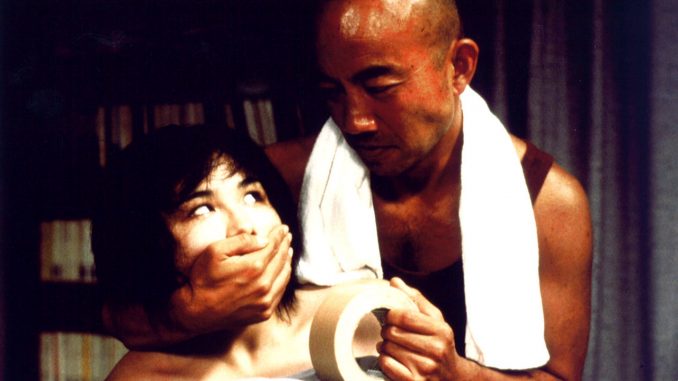
Rating: C-
Dir: Ben Wada
Star: Naoto Takenaka, Hijiri Kojima, Eriko Watanabe, Kazuki Kitamura
As promised when I reviewed Part 2, I’ve gone back and taken a look at the original. To be honest, this didn’t seem to have much to offer. Some of that may be due to the sequel having largely stolen most of this film’s thunder. The concept is, basically identical: a young woman is abducted off the street by a lonely, middle-aged man who holds her captive. Over time, she begins to feel affection for him – something both film accept unquestioningly and without any apparent awareness of Stockholm Syndrome. Justice needs to prevail, and the film ends with the woman being freed from her captivity – though not without ambivalence as the outcome.
 So, if you’ve seen one film, you’ve more or less seen the other, and I’m baffled as to how such a slim concept could stretch to a total of seven movies, between 1999 and 2010. [I won’t be pursuing the series any further] Yet there are some differences in the approach here, albeit not ones which I would say work to its benefit. For instance, Iwazono (Takenaka), the perpetrator here, is clearly not an entirely hopeless case. He was married once before, albeit to a woman he assaulted at work, who subsequently left him. But even now, there’s a lady at his current job, who clearly has an interest in him. This robbed Iwazono of some sympathy for me, because he has options – things that don’t involve kidnapping teenage women who are out jogging, as he does here to Kuniko (Kojima).
So, if you’ve seen one film, you’ve more or less seen the other, and I’m baffled as to how such a slim concept could stretch to a total of seven movies, between 1999 and 2010. [I won’t be pursuing the series any further] Yet there are some differences in the approach here, albeit not ones which I would say work to its benefit. For instance, Iwazono (Takenaka), the perpetrator here, is clearly not an entirely hopeless case. He was married once before, albeit to a woman he assaulted at work, who subsequently left him. But even now, there’s a lady at his current job, who clearly has an interest in him. This robbed Iwazono of some sympathy for me, because he has options – things that don’t involve kidnapping teenage women who are out jogging, as he does here to Kuniko (Kojima).
He also lives in an apartment building, which broadens out the focus to include other characters like the building’s owner (Watanabe), as well as other residents, such as a transvestite salesman, played by the director of Tetsuo, Shinya Tsukamoto. Apart from the obvious unanswered question – why they appear oblivious to Kuniko’s piercing shrieks when she initially regains consciousness in her abductor’s flat – their presence does more to dilute the focus, than add very much to the film. Wacky goings-on involving bottled water and boxing felt ill at ease with the more salacious elements. To the film’s credit, those are relatively restrained – or, at least put off until well into the movie, so if you’re simply after Japanese tits (I’m not one to judge), you’ll want to have the fast-forward handy.
There seems to be more of an S&M element here – 50 Shades of Geisha, perhaps? – with the handcuffs Iwazono uses on Kuniko being a symbol for their relationship. Eventually, she not only escapes their constraints, she puts them on him, and wanders away from their hot spring hotel, before deciding to return of her own free will. That’s a turning point in their relationship, just as the scissors scene was in the sequel. I must admit, there’s something weirdly intriguing about a sexual predator, who virtually starts off by saying to his victim, “I’d like to apologize. I’m sorry for kidnapping you,” who states he is seeking a “perfect melding of mind and body” and eagerly anticipates the death penalty. Whether any of it makes sense, though, I’m far from convinced.
